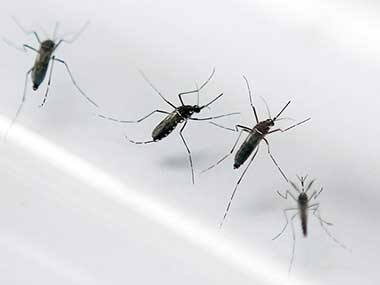An unusually long rainy season and resultant humidity have resulted in a big spurt in cases of dengue in the national capital. The number of cases reported in hospitals had touched 1,259 till 5 September, the highest since 2010. Only 33 cases of dengue fever had been tested positive till 5 September in the previous year. As many as 778 cases were reported in August this year. North Delhi is the worst affected with as many as 511 cases reported from this area so far and East Delhi has reported the lowest with around 110 cases. The Health department has asked all hospitals to increase number of beds to accommodate patients. [caption id=“attachment_2426190” align=“alignleft” width=“380”]
 Dengue mosquitoes . AFP image[/caption] According to a preliminary report released by All India Institute of Medical Science (AIIMS), Type 2 and Type 4 strains of the disease have emerged as the dominant subtypes this season. However, DN 4 has contributed most to the alarming rise in dengue cases this time. Since both involve a drop in the level of platelets, people have been crowding hospitals and blood banks to ensure availability of platelets for personal use. The advice of experts that treatment of dengue is not always about the platelet count, has not done much to ease the sense of panic. “Till 2003, the predominant serotype was DV-2 (genotype IV) but in 2003, for the first time, all four dengue virus sub-types were found to be circulating in the city. The same was witnessed in 2003-2004 as well. Further, replacement of DV-2 and 3 with DV-1 as the predominant serotype in Delhi over a period of three years (2007-2009) has been reported. In 2013, DV-2 once again returned as the most common strain. More than 5,500 cases were reported that year,” Dr Lalit Dar, professor at Microbiology Department, AIIMS, told Firstpost. Though the four strains have been in circulation for the past few years, DN-4 has not been dominant in Delhi for last few years, he said, adding “the unusually long rainy season and high level of humidity were among factors contributing to the spurt in the cases this year. Both DN-2 and DN-4 are virulent strains can be fatal if not detected and treated at early stage.” While the symptoms of DN-2 include a sharp decline in platelets count, hemorrhagic fever, dengue shock syndrome and organ failure, patients suffering from DN-4 have fever with shock and a drop in platelets, he said. Given the rush for platelets, the Delhi Health Department has asked all government and private blood banks to keep stock of blood in adequate quantity. There is no specific medicine to cure dengue. “Antibiotics do not work and other medicines are not prescribed because they bring down the platelet count, which may increase bleeding. To bring down the high fever, paracetamol is given to patients. Drinking plenty of fluids, eating nutritious, taking rest properly and stay in consultation with a physician is advisable,” said Dr RN Dass, MSNH (Patient Welfare Cell), Delhi government.
Dengue mosquitoes . AFP image[/caption] According to a preliminary report released by All India Institute of Medical Science (AIIMS), Type 2 and Type 4 strains of the disease have emerged as the dominant subtypes this season. However, DN 4 has contributed most to the alarming rise in dengue cases this time. Since both involve a drop in the level of platelets, people have been crowding hospitals and blood banks to ensure availability of platelets for personal use. The advice of experts that treatment of dengue is not always about the platelet count, has not done much to ease the sense of panic. “Till 2003, the predominant serotype was DV-2 (genotype IV) but in 2003, for the first time, all four dengue virus sub-types were found to be circulating in the city. The same was witnessed in 2003-2004 as well. Further, replacement of DV-2 and 3 with DV-1 as the predominant serotype in Delhi over a period of three years (2007-2009) has been reported. In 2013, DV-2 once again returned as the most common strain. More than 5,500 cases were reported that year,” Dr Lalit Dar, professor at Microbiology Department, AIIMS, told Firstpost. Though the four strains have been in circulation for the past few years, DN-4 has not been dominant in Delhi for last few years, he said, adding “the unusually long rainy season and high level of humidity were among factors contributing to the spurt in the cases this year. Both DN-2 and DN-4 are virulent strains can be fatal if not detected and treated at early stage.” While the symptoms of DN-2 include a sharp decline in platelets count, hemorrhagic fever, dengue shock syndrome and organ failure, patients suffering from DN-4 have fever with shock and a drop in platelets, he said. Given the rush for platelets, the Delhi Health Department has asked all government and private blood banks to keep stock of blood in adequate quantity. There is no specific medicine to cure dengue. “Antibiotics do not work and other medicines are not prescribed because they bring down the platelet count, which may increase bleeding. To bring down the high fever, paracetamol is given to patients. Drinking plenty of fluids, eating nutritious, taking rest properly and stay in consultation with a physician is advisable,” said Dr RN Dass, MSNH (Patient Welfare Cell), Delhi government.
Delhi: Cases of Dengue fever have touched 1,259, highest in five years
Tarique Anwar
• September 8, 2015, 21:02:31 IST
An unusually long rainy season and resultant humidity have resulted in a big spurt in cases of dengue in the national capital.
Advertisement
)
End of Article